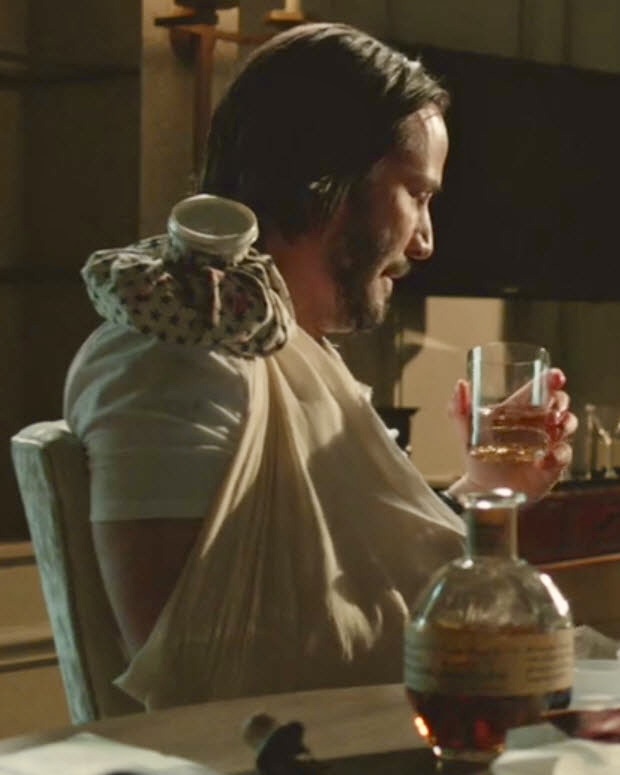Whiskey Product Placement

You’ve probably been watching a movie or TV show, and noticed a character pour themselves a drink, only to realize you can clearly read the label on the bottle. It’s not a generic “Whiskey” or a made-up brand; it’s a real, recognizable bottle of Bulleit, Blanton’s, or Buffalo Trace. This isn’t a coincidence; it’s a carefully orchestrated marketing strategy known as product placement.
From the rugged cowboy in Yellowstone sipping on a classic Buffalo Trace to the sophisticated assassin in John Wick savoring a single-barrel Blanton’s, these moments are more than just set dressing. They’re a subtle, yet powerful, way for a brand to connect with an audience and meant to influence sales. So, how does this all happen?
Who Arranges the Placement?
When you see a specific bottle of whiskey on screen, it’s the result of a collaboration between the brand and the production team. Often, this is handled by a product placement agency. These agencies act as a liaison, connecting brands with film and television productions that need props, costumes, and other set elements.
Set decorators, prop masters, and other members of the production crew are constantly looking for authentic items to make a scene feel real. They might reach out to an agency with a specific request—say, for a high-end bourbon to be featured in a character’s office—or a brand might proactively pitch their product to a production they believe aligns with their image. Sometimes, the connection is even more direct. Production crews post about what products they need, and brands that offer those products can send them directly to the set. This is a mutually beneficial arrangement: the production gets free props, and the brand gets valuable screen time.
How Much Does It Cost?
The cost of product placement can vary wildly. It’s not always a straightforward cash transaction.
Paid Placements: For a prominent, guaranteed placement—like a character specifically mentioning the brand name or a bottle being the focal point of a scene—brands probably pay a fee. These “fee deals” can range from tens of thousands of dollars to millions for major blockbuster films.
For example, some sources suggest Heineken paid an estimated $45 million for James Bond to drink its beer in Skyfall.
In-Kind Placements: Many placements happen with no money changing hands. In these “in-kind” or “trade-out” deals, a brand provides products to the production in exchange for the chance to be featured. For smaller brands or productions, this can be a lifesaver, as it helps offset the cost of props. The catch? There’s no guarantee the product will make it into the final cut.
Organic Placements: Sometimes, a brand’s appearance is purely organic. A director might choose a certain brand simply because it’s their personal favorite, or because they believe it adds an authentic touch to a scene. The famous volleyball “Wilson” in the movie Cast Away is a prime example of an organic placement that became iconic.
What are the Guidelines?
Alcohol product placement comes with a specific set of guidelines. These are often a mix of federal regulations and self-regulatory standards from the industry itself, such as the Distilled Spirits Council of the United States (DISCUS). The main goal is to promote responsible drinking and avoid marketing to underage audiences.
Key guidelines include:
Targeting Adults: Advertisements and placements must primarily appeal to individuals 21 or older. This means avoiding content that uses cartoon characters or themes that might appeal to minors. Most industry guidelines suggest that at least 70% of the audience for a given show or film should be of legal drinking age.
No Health or Social Claims: The placement cannot suggest that drinking a particular brand will lead to social, professional, or athletic success. It’s about showing the product as a part of a character’s life, not as a magic potion for success.
Responsible Portrayal: The portrayal of alcohol consumption should be responsible. This means avoiding scenes that glamorize binge drinking and never showing a character drinking and driving or engaging in other illegal activities.
The next time you see a character on screen pour themselves a whiskey, take a closer look. That bottle of Bulleit, Blanton’s, or Buffalo Trace is more than just a prop—it’s a carefully placed piece of marketing that tells a story and connects a brand with its audience. It’s meant to be realistic and meant to influence you to select it off the shelf on your next trip to the store.

Leave a Reply
Become an insider and receive weekly advice, tips, and insight on all things whiskey
.
Weekly tips, reviews and recommendations to help you enjoy whiskey life to the fullest.
JOIN THE LIST
Sippin' With Jordan Davis
sippin' with the stars
Million Dollar Cowboy Bar WY
old fashioned aF
5 Steps To Sip and Savor Whiskey
whiskey 101
COMMENTS